Previewing Silicon Motion SM2260 NVMe Controller With 3D MLC NAND (512GB)
by Billy Tallis on February 17, 2017 9:00 AM ESTMixed Random Read/Write Performance
The mixed random I/O benchmark starts with a pure read test and gradually increases the proportion of writes, finishing with pure writes. The queue depth is 3 for the entire test and each subtest lasts for 3 minutes, for a total test duration of 18 minutes. As with the pure random write test, this test is restricted to a 16GB span of the drive, which is empty save for the 16GB test file.
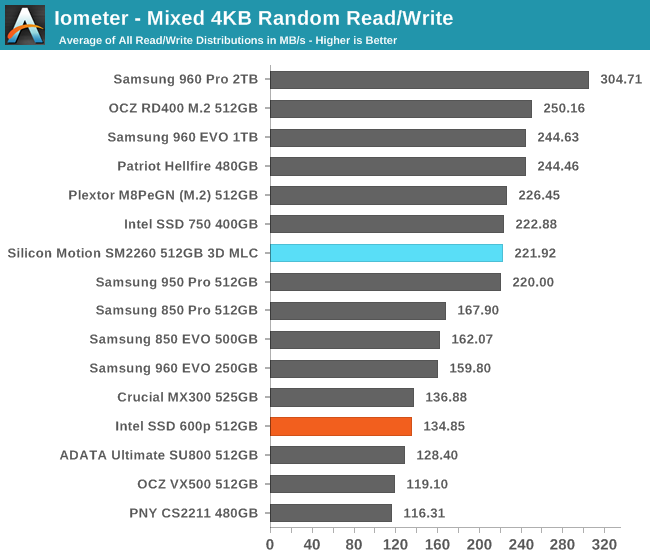
The SM2260 sample scores in the lower tier of NVMe SSDs for mixed random I/O, but this is still much faster than SATA SSDs. The Patriot Hellfire and OCZ RD400 have a bit of an edge, and the Plextor M8Pe is very slightly faster.
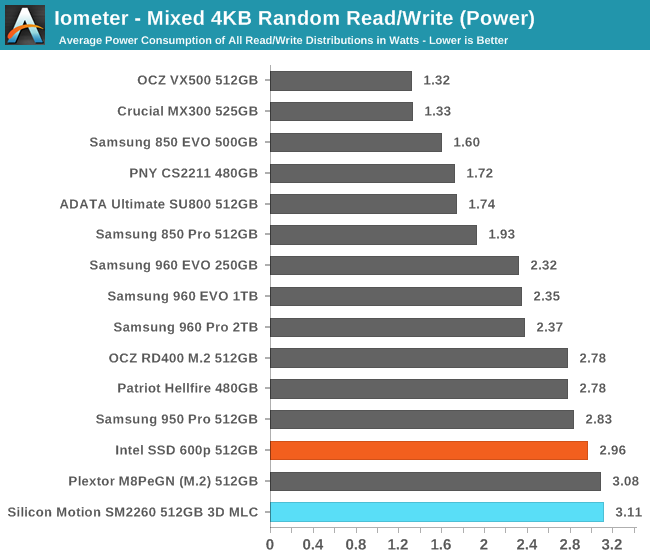
The SM2260 sample has the highest power consumption among M.2 or SATA SSDs, so it's less efficient than all of its competition.
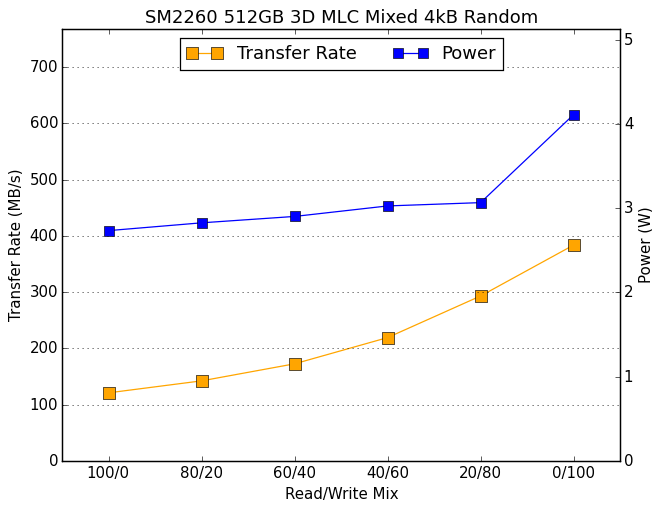 |
|||||||||
The SM2260 sample's performance gradually increases as the portion of writes grows. Power consumption jumps substantially in the final phase of pure writes, but the performance increase is disappointing.
Mixed Sequential Read/Write Performance
The mixed sequential access test covers the entire span of the drive and uses a queue depth of one. It starts with a pure read test and gradually increases the proportion of writes, finishing with pure writes. Each subtest lasts for 3 minutes, for a total test duration of 18 minutes. The drive is filled before the test starts.
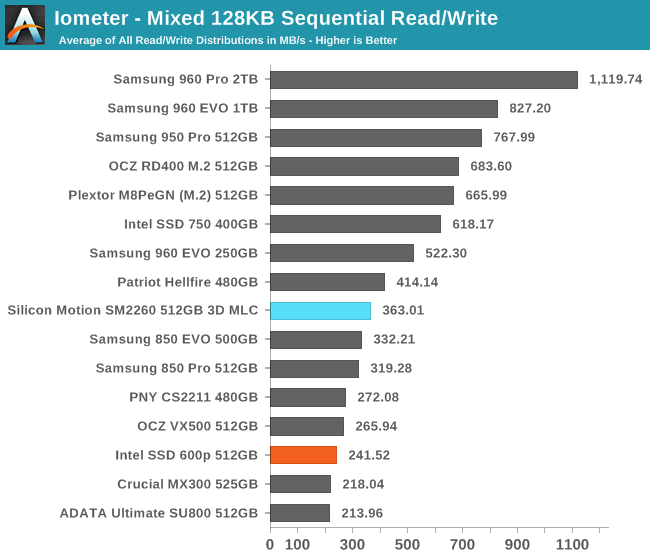
The mixed sequential I/O performance of the SM2260 sample is a little bit slower than the next slowest MLC-based NVMe SSD and a little bit faster than the best SATA SSD.

The SM2260 sample's power consumption is a little high by NVMe standards but it isn't setting a record. The efficiency is sub-par due to the low performance.
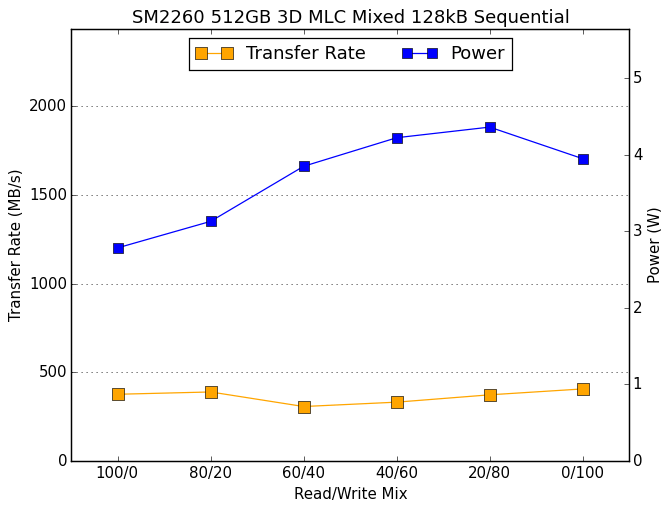 |
|||||||||
Performance from the SM2260 sample wobbles a little over the course of the mixed sequential I/O test but is mostly steady. Most drives perform substantially better at either end of the test when the workload is predominantly reads or writes, but the SM2260 does manage to maintain a slightly better minimum than the Patriot Hellfire's worst.










27 Comments
View All Comments
BrokenCrayons - Friday, February 17, 2017 - link
It seems like power consumption and consistency are both problems. Consistency can probably be addressed through tuning and optimization of firmware, but power consumption is probably something that can't be fine-tuned away. NVMe drives aren't as power friendly as SATA, but the inefficiencies of some recently reviewed SSDs here on Ananatech certainly seems to throw a spotlight on the problem. Between that and thermal throttling, the NVMe storage picture isn't very rosy just yet.KAlmquist - Friday, February 17, 2017 - link
Even with 25% overprovisioning, I see a 1 second interval at the 3350 mark where the IOP's fall to zero. Fortunately, the performance consistency of this SSD seems more in line with its competitors on the trace-based benchmarks (The Destroyer, etc.).The sequential read performance at queue depth 1 is lower than that of budget SATA SSD's like the MX300. At higher queue depths, the sequential reads are faster than anything a SATA SSD can manage, but queue depths of 1 are not uncommon in a desktop environment.
vladx - Saturday, February 18, 2017 - link
Now we can see why Micron cancelled its' NVMe SSD using the SM2260, it's simply not competive.Drumsticks - Saturday, February 18, 2017 - link
So what's a good roundup conclusion on the current state of NVMe drives? If we want to pick one up this year, where does the performance go from "bad for NVMe" to "not Samsung but still pretty good!"? Plextor?vladx - Saturday, February 18, 2017 - link
Indeed Plextor M8Pe seems to be the best buy option at the moment in the NVMe space.Drumsticks - Saturday, February 18, 2017 - link
That's what I was thinking. $220/$240 for the 500GB model right now. So much more than it used to be. Do we have any news on whether anything constraining nand supply will be alleviating any time soon?vladx - Saturday, February 18, 2017 - link
The supply problems most likely will be gone after Chinese companies will flood this market in 2018. But it could happen sooner than that depending on how fast will Toshiba/Western Digital will be rolling up their own 3D NAND supply.Chaser - Saturday, February 18, 2017 - link
"and the Plextor M8Pe is very slightly faster."AbRASiON - Sunday, February 19, 2017 - link
If this is CHEAPER than an MX300 it's an incredibly good bargain. The MX300's are really really well priced. I'd consider it if it's dead, dead cheap.The 960 Evo / Pro is a joke, sure it's fast but in real world usage, it's ridiculously expensive.
Make the 1TB version of this for $250 US or less and I'm very much in. (I doubt it will though)
StrangerGuy - Sunday, February 19, 2017 - link
I know right, Techreport tested the 960 Evo/Pro are both so close to yesteryears SATA3 SSDs in real-world load times that they are easily within the margin of error. I don't care about how NVMe is able to reach uber fast raw speeds that has zero use to me or to 99% of the people out there, but a hypothetical SSD with half the raw transfer speed of current SATA3 SSDs for 2x the capacity per dollar? That's a real bargain.